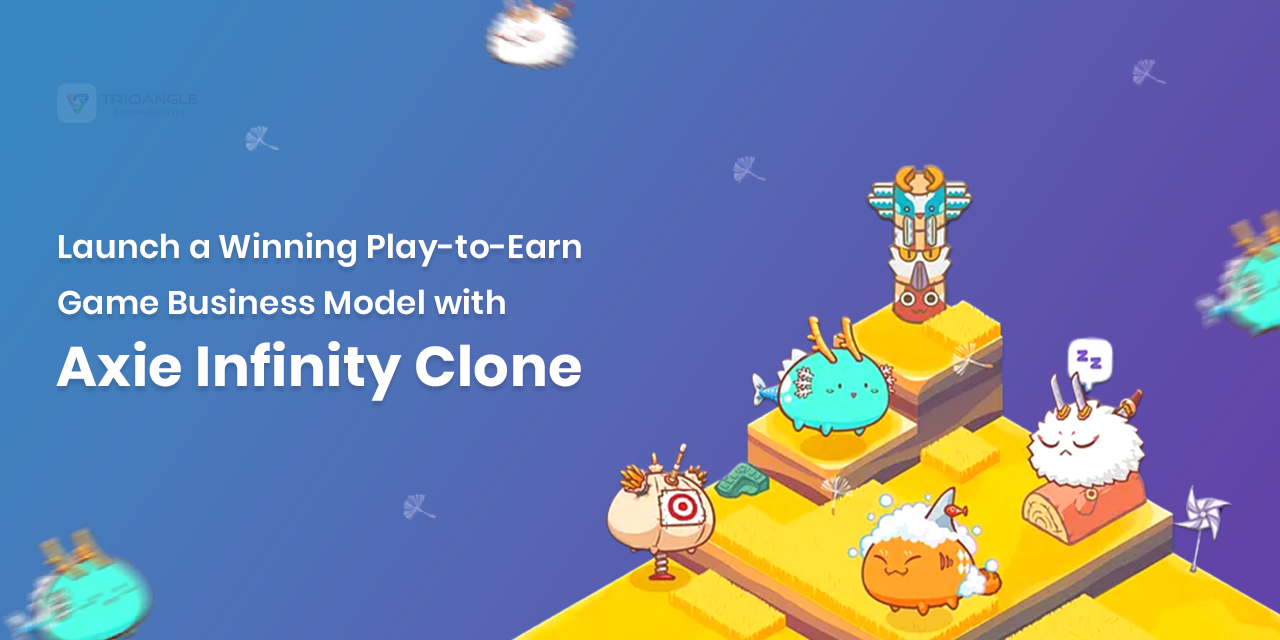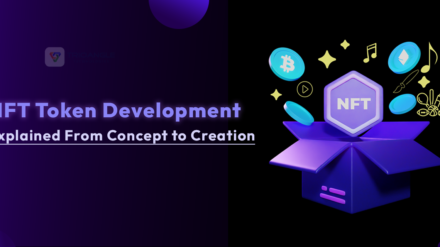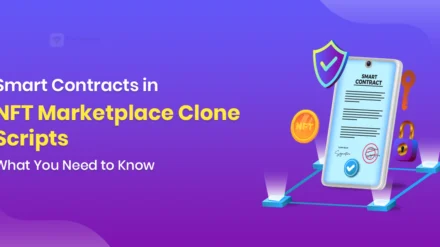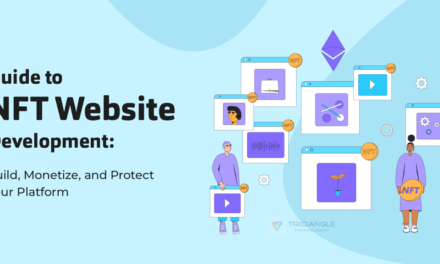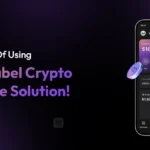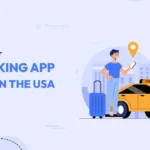Back in the day, gaming meant escaping reality. Today, it pays to play.With the rise of the play-to-earn game business model, games have become digital economies. where skill meets ownership. It’s not just about high scores anymore. It’s about earning assets, trading NFTs, and unlocking real-world value. Entrepreneurs are catching on, especially with tools like the Axie Infinity clone script. Which turns gaming ideas into full-fledged blockchain ventures.
This blog pulls back the curtain. If you’re serious about launching in Web3 gaming, this is where your blueprint begins.
What are Play-to-Earn (P2E) Games?
Play-to-earn games are not a trend. They’re a restructuring of value inside the gaming world. At surface level, it looks like players earn crypto by playing. However behind the scenes, it’s about something more structural….
“A player-driven economy that merges gameplay with digital asset ownership”
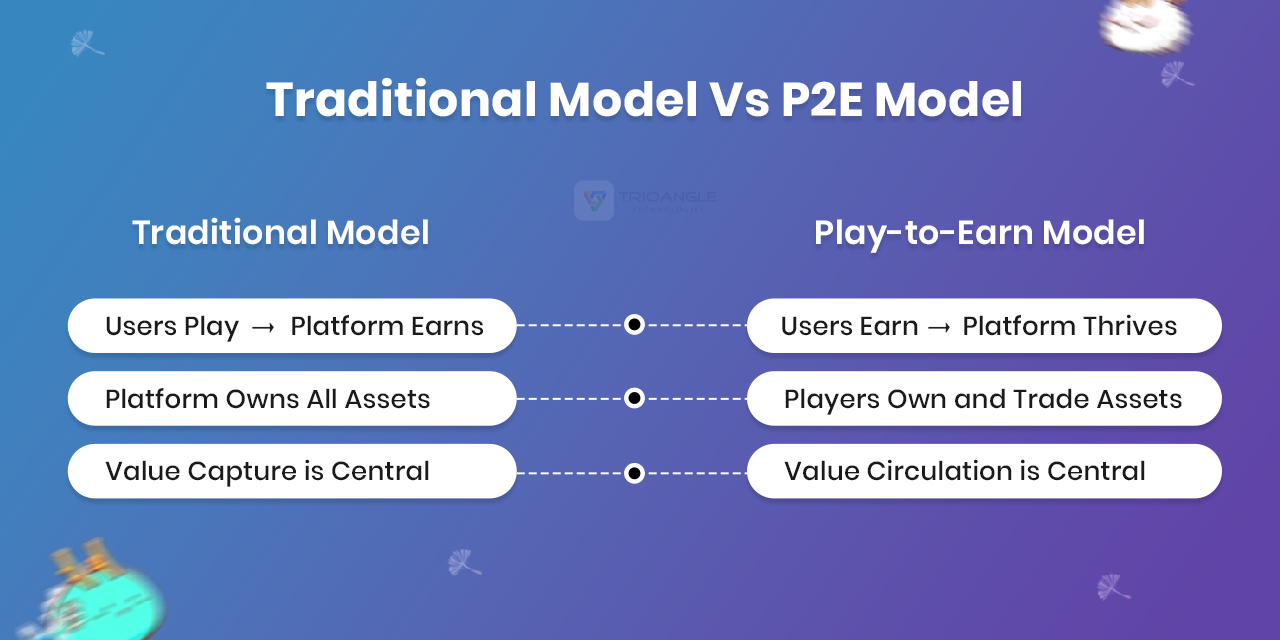
In traditional games, all value flows to the publisher. But in the play-to-earn gaming industry, players become stakeholders. The assets they earn characters, skins, tokens exist on-chain. That means they’re tradable, lendable, and investable. And this shifts the entire Play-to-Earn game business model.
Real examples like Axie Infinity showed how these economies could scale. Many clones missed this. They copied the basic mechanics but skipped the economy design. The loop where value enters, circulates, and exits sustainably. That’s where most Axie Infinity clone software cases fall short.
As we discussed in our X-to-earn model breakdown, success comes when gameplay, tokenomics, and user incentives align. A real play-to-earn game business model begins here not with hype, but with system design.
The Evolution of Play-to-Earn Game Business Model: How We Got to Play-to-Earn
If you’re building a Play-to-Earn platform today. Or using an Axie Infinity clone software to do it. You first need to understand the path that got us here. P2E isn’t just the next phase of gaming. It’s a radical shift in how digital economies are designed, distributed, and owned.
Let’s take a walk through the timeline.
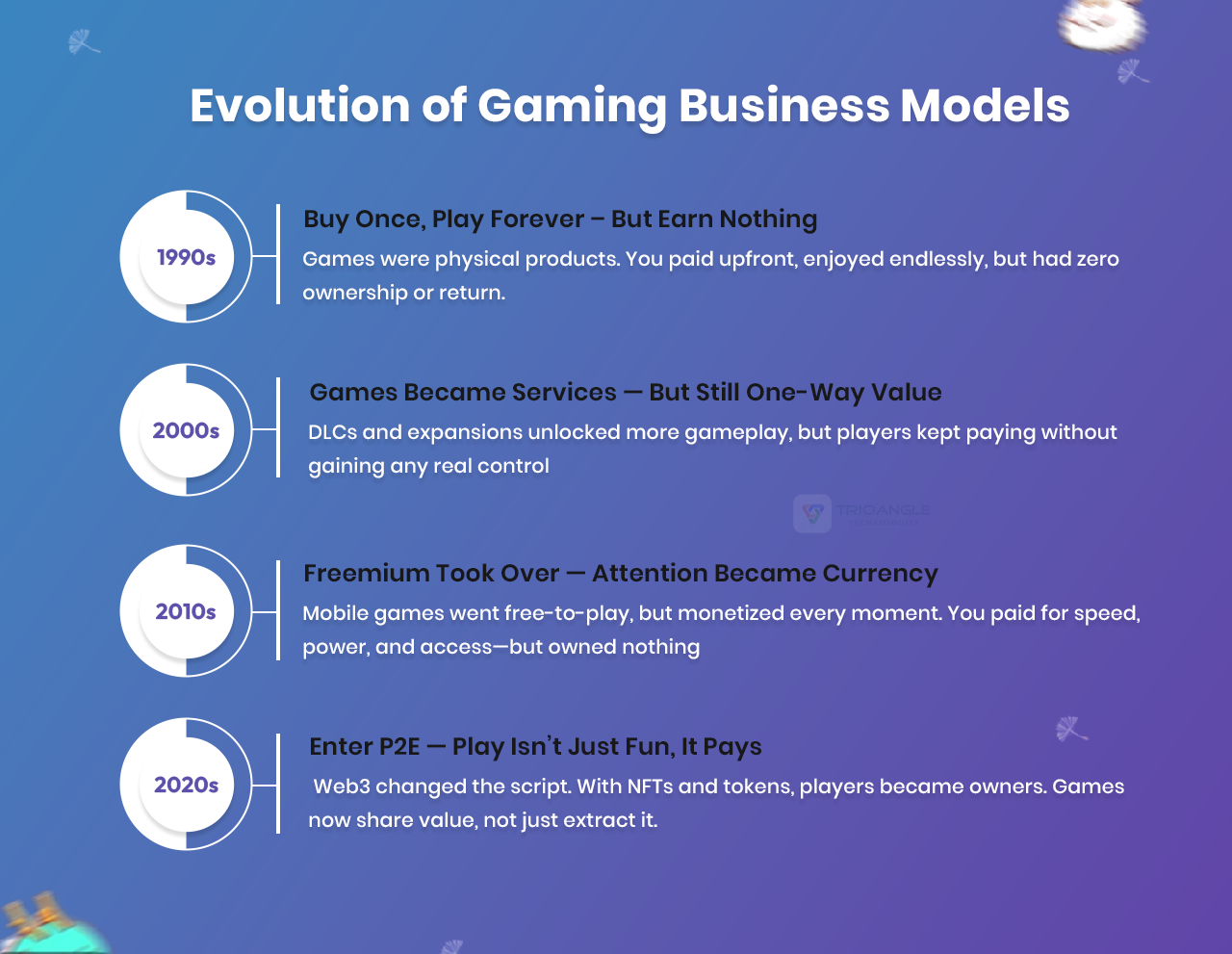
1990s: The “Buy Once, Own Forever” Era
- Back in the 90s, the gaming business model was simple. Developers built a game, shipped it on a CD-ROM or cartridge, and sold it for a one-time price.
- That was it. Players owned a copy, but their relationship with the game ended at the point of purchase.
- No updates. No add-ons. No online connection. Revenue was entirely front-loaded, which meant developers had one shot to succeed.
- You’d buy a boxed PC game, play it offline, and that was your whole experience.
“Games like Doom, Warcraft II, or Super Mario 64 ruled this era. Fun was central but monetization was straightforward and static.”
2000s: Expansion Packs, DLCs & the Rise of Freemium
- In the early 2000s, game developers started changing their approach. Rather than relying solely on one-time sales. They found new ways to keep players engaged and keep revenue flowing.
- By offering downloadable content (DLC) and expansion packs they gave gamers the option. To pay for extra missions, new maps, weapons, or fresh storylines, long after the original purchase.
- This also introduced the freemium model: games were free to play at the base level. But players paid for meaningful content. The model worked because developers now had multiple revenue events across a game’s lifecycle.
“The Sims, World of Warcraft, and Counter-Strike helped define this stage”
However, control still remained centralized. Players paid for content, but they didn’t own anything that could retain or grow in value.
2010s: Mobile Gaming and the Age of Microtransactions
The arrival of smartphones completely transformed how games made money.
- Once mobile stores like Google Play and the App Store went mainstream…
- Gaming turned into a non-stop, worldwide experience.
- Games like Clash of Clans, PUBG Mobile, and Candy Crush led the charge with a new model. Free to start, but full of tempting add-ons.
- Players could dive in for free… but many chose to pay for in-game boosts, custom looks, bonus lives, or digital currency to progress faster.
- The business model here wasn’t about selling content. It was about selling convenience and progression. The longer you stayed, the more likely you were to spend.
- Developers monetized time and attention, and they optimized for addiction loops.
But again, all purchases were sunk costs. You couldn’t trade your skins or tokens. Ownership didn’t exist. Even if you spent hundreds of dollars, you owned nothing outside the closed system.
2020s: Blockchain, Digital Assets, and the Play-to-Earn Paradigm
This is where the script flips entirely.
Play-to-Earn (P2E) introduced an entirely new layer.
- Players could earn real assets, hold them in their wallets, and trade them freely on open markets.
- Games were no longer closed platforms; they became decentralized economies.
- With NFTs and blockchain integration, users now owned in-game assets with provable scarcity.
- Whether it was a character, a sword, or a virtual plot of land. It existed outside the game server and had real-world liquidity.
- Projects like Axie Infinity, Decentraland, and The Sandbox were early pioneers of this shift.
This gave birth to the play-to-earn game business model, where players don’t just play. they participate in a live financial system. They earn tokens, upgrade NFTs, and either reinvest or monetize their time. The platform and the player now share the value generated.
How Play-to-Earn Game Business Models Beyond Gaming
Play-to-earn was never just about games. It was about rewriting how participation creates value. While the earliest examples came from gaming platforms. What we’re now witnessing is far more expansive:. An economic shift where users are no longer consumers only. They’re contributors, investors, and co-owners of the ecosystem.
In a traditional setup, users pay to access features. But in the play-to-earn game business model, platforms pay users for contributing value. Whether that’s in the form of gameplay, digital asset interaction, or in-game trade… Play-to-Earn game business model opens a loop where time becomes a resource not only attention.
This concept is influencing sectors outside of gaming:
- In fitness: Move-to-Earn models reward physical activity.
- In education: Learn-to-Earn incentivizes knowledge acquisition.
- Even in social media: engagement metrics are becoming monetizable assets.
These trends are not accidents. They stem directly from principles pioneered in blockchain gaming platforms and web3 games.
The success of early platforms like Axie Infinity didn’t just come from gameplay. It came from letting users own, earn, and circulate assets. This logic is now the foundation of more adaptive, scalable startup models across sectors.
And for businesses using Axie Infinity clone software, this insight matters. You’re not just replicating a game… You’re inheriting a framework for decentralized interaction, tokenized value exchange, and long-tail monetization strategies. That can reach far beyond the NFT game marketplace.
This is where the real play-to-earn game business model lies. Not in the gameplay loop, but in designing systems. Where user activity powers the product itself.
Axie Infinity Clone: How to Create a Play-to-Earn Game Business Model
To build a sustainable play-to-earn game business model… Especially one inspired by something like Axie Infinity clone software… You need to shift your mindset from game launch to economy design. You’re not just building a game. You’re bootstrapping a self-sustaining, reward-driven economy. That survives player churn, token speculation, and market cycles.
Let’s break that into four real-world, battle-tested foundations:
#1 Build a Marketplace That Reinforces the Game Loop
Most clones launch with two tokens and a breeding system. But that’s not a business model. It’s just a framework. To build a real P2E game business case, start with the value loop:
- Earn – Player completes battles or tasks
- Spend – Uses rewards to breed, upgrade, or trade assets
- Burn – Token sinks that reduce supply through in-game functions
- Reinvest – Players buy NFTs or tokens to stay competitive
Tip: If players aren’t reinvesting in the system, your economy will become extractive. That’s when the loop breaks.
#2 Key Mechanics That Support Sustainable Monetization
If you’re using NFT game clone software, understand this: features aren’t enough. The real product is the behavior your system creates.
Here’s what you need to engineer into your game’s core design:
- Controlled Breeding Logic: Letting users mint endless NFTs crashes the economy. Add cooldowns, token costs, rarity barriers, and population caps.
- Tiered Progression Systems: Create ranked seasons, level caps, or tournament ladders. Give people a reason to keep grinding for status or access.
- Circular Marketplace Fees: Charge transaction fees on trades. but don’t just pocket them. Redirect some of it into reward pools or token staking to maintain player incentives.
If your clone doesn’t push players to grow and spend value inside your game, it won’t last.
#3 Enable Multi-Stakeholder Ecosystems (Guilds, Collectives, Jobs)
Here’s where you create a real NFT game monetization strategy:
- Let guilds or DAOs own game assets and rent to players (like scholars).
- Build mechanics for revenue sharing, e.g., managers take a % cut from players’ wins.
- Offer exclusive access or perks for top contributors, incentivizing real community labor.
#4 Want Your play-to-earn game business model to Succeed? Build It Like a Real Economy
To make your Axie clone stand out, you need to go beyond duplication and actually design for retention and reinvestment.
Here’s what you should focus on:
- Asset Supply Control: NFTs and tokens should feel scarce, valuable, and earned.
- Incentive Realignment: Players should want to play more, not just cash out. Design in-game goals that make them reinvest, not exit.
- Healthy Deflation: Burning tokens shouldn’t feel like punishment. Make it part of progression like crafting elite NFTs or unlocking premium modes.
- No Token Dependency: Don’t rely on token price pumps to carry your game. Build fun loops first. Make the economy serve the gameplay.
What Are the Revenue-Generating Business Models Behind Play-to-Earn (P2E) Games?
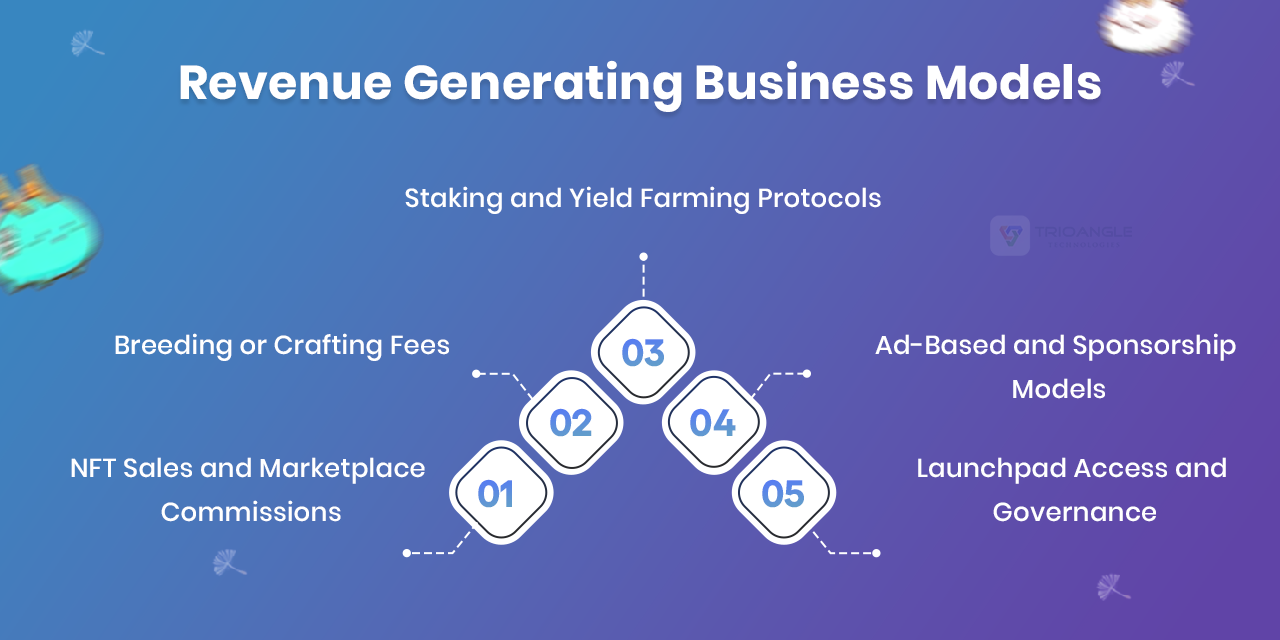
The most successful P2E models balance three things:
- Player earning potential
- Platform profit reliability
- Economic sustainability through smart token design
#1 NFT Sales and Marketplace Commissions
One of the foundational revenue streams is tied to in-game NFT assets.
- Players buy these NFTs either directly from the platform or from other users.
- The platform earns through initial NFT minting sales and transaction fees. From every peer-to-peer trade on its marketplace.
For example, in an Axie Infinity clone, the game might take a 4.25% cut every time two players trade Axies. Over time, these small fees add up to substantial revenue.
#2 Breeding or Crafting Fees
Many P2E games incorporate mechanics like breeding or crafting. where users can combine or mutate NFTs to create new, possibly more valuable ones.
The catch? It’s not free.
- Users must pay fees often in tokens or stablecoins.
- The platform collects those fees, either as profit or as a burn mechanism.
This is a major monetization route. For instance, during Axie Infinity’s peak, breeding fees alone generated millions in daily revenue.
#3 Staking and Yield Farming Protocols
Some advanced P2E platforms give users options to stake tokens or NFTs. To earn interest or governance rights.
Here’s how it turns into revenue:
- Platforms lock up liquidity in pools.
- They might charge a performance fee on staking rewards.
- Or offer premium staking tiers that come with a subscription or entry cost.
This model also encourages long-term holding, which stabilizes token value.
#4 Ad-Based and Sponsorship Models
Some free-to-play P2E games use non-intrusive advertising to generate revenue without compromising gameplay:
- In-game banners or billboards
- Sponsored challenges or tournaments
- Partnered NFT drops
Brands benefit from targeted exposure. The game earns revenue. Players still enjoy a seamless experience.
Note: This model works best when integrated organically. not shoved into the player’s face like traditional mobile ads.
#5 Launchpad Access and Governance
Some P2E games evolve into platform ecosystems by launching other games or NFT projects. Players who stake or hold certain tokens might get access to:
- Early NFT sales
- Governance votes
- Premium features or drops
The platform can charge access fees or take a cut of launchpad sales, creating another stream of income.
A Few Last Insights to Carry With You!!!
The real power of the Play-to-Earn game business model isn’t just in minting NFTs or cloning features from an Axie Infinity clone script. It’s in designing an economy where time, skill, and digital ownership hold value across platforms.
Founders who approach P2E like a short-term trend will burn out. But those who design with regenerative loops, community-led value, and cross-chain scalability in mind?. They’ll be building the financial engines of tomorrow’s metaverse. This isn’t about games anymore. Future-proof P2E games will blend engaging mechanics with real financial utility. Those who get this balance right… they’ll lead the next evolution of the play-to-earn gaming industry.

